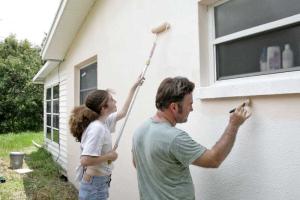Ultimate Guide to Prep, Prime, and Paint Exterior Stucco for Lasting Results

-
Quick Links:
- Understanding Exterior Stucco
- Importance of Proper Preparation
- Gathering Your Tools and Materials
- Step-by-Step Guide to Prep, Prime, and Paint
- Case Studies and Real-World Examples
- Expert Insights and Tips
- Common Mistakes to Avoid
- FAQs
Understanding Exterior Stucco
Stucco is a popular exterior finish for homes due to its durability, versatility, and aesthetic appeal. Made from a mixture of cement, sand, and lime, stucco can be applied over various surfaces, including concrete, masonry, and wood. However, over time, stucco can wear down, fade, or become stained, requiring proper maintenance, including painting.
Importance of Proper Preparation
Preparing your stucco surface before painting is crucial to ensure a long-lasting finish. Without proper preparation, paint can peel, chip, or fade prematurely. The steps include cleaning, repairing any damage, and priming the surface to enhance adhesion.
Gathering Your Tools and Materials
- Pressure washer or garden hose with spray nozzle
- Scrub brush or sponge
- Repair materials (stucco patch, caulk)
- Primer (specifically for stucco)
- High-quality exterior paint (100% acrylic recommended)
- Paintbrushes, rollers, and a paint sprayer (optional)
- Drop cloths and painter's tape
- Safety gear (gloves, goggles, mask)
Step-by-Step Guide to Prep, Prime, and Paint
Step 1: Clean the Surface
Start by cleaning the stucco surface to remove dirt, mold, and mildew. A pressure washer is ideal for this task, but a garden hose with a scrub brush can work as well. Make sure to let the surface dry completely before proceeding.
Step 2: Inspect and Repair
Check for cracks, chips, or holes in the stucco. Use a stucco patch to repair any damage, ensuring a smooth and even surface. Allow the repairs to cure fully according to the manufacturer's instructions.
Step 3: Prime the Stucco
Applying a primer is essential for better paint adhesion. Use a primer specifically designed for stucco. Apply it using a roller, brush, or sprayer, ensuring complete coverage. Allow the primer to dry completely before moving to the next step.
Step 4: Painting the Stucco
Choose a high-quality exterior paint, preferably 100% acrylic, for durability and weather resistance. Start painting from the top down to avoid drips. Use a brush for edges and a roller for larger areas. For a smooth finish, consider using a paint sprayer.
Step 5: Apply a Second Coat
Once the first coat is dry, inspect for coverage. If needed, apply a second coat for a uniform appearance. Allow the paint to cure completely as per the manufacturer's guidelines.
Case Studies and Real-World Examples
In a case study involving residential homes in California, homeowners who followed a thorough prep process reported a 50% increase in the longevity of their painted stucco finish compared to those who skipped the priming step. This highlights the importance of adhering to best practices in stucco maintenance.
Expert Insights and Tips
According to home improvement expert Jane Doe, "The key to a successful stucco painting project lies in the preparation. Don't rush through the cleaning and priming stages; they set the foundation for the entire job."
Common Mistakes to Avoid
- Skipping the cleaning step, which can lead to poor paint adhesion.
- Using the wrong type of paint or primer.
- Not allowing sufficient drying time between steps.
- Ignoring weather conditions; painting in high humidity or rain can ruin the finish.
FAQs
1. How often should I paint my stucco exterior?
Typically, stucco should be repainted every 5-10 years, depending on weather conditions and the quality of the previous paint job.
2. Can I paint over old paint on stucco?
Yes, but it's crucial to prepare the surface properly by cleaning and possibly priming to ensure good adhesion.
3. What type of paint is best for stucco?
100% acrylic paints are recommended for their durability and resistance to fading and mildew.
4. Do I need to use a primer on stucco?
Yes, a primer specifically designed for stucco is essential for better paint adhesion and a longer-lasting finish.
5. How can I tell if my stucco needs painting?
Signs include fading color, peeling paint, cracks, or mold growth on the surface.
6. What is the best time to paint stucco?
The best time is during dry weather with mild temperatures, typically in late spring or early fall.
7. Can I use a paint sprayer on stucco?
Yes, a paint sprayer can provide a smooth finish, but it's essential to control the spray to avoid overspray and ensure even coverage.
8. How do I clean stucco before painting?
Use a pressure washer or a scrub brush with a mixture of water and mild detergent to remove dirt and mildew.
9. How long does it take for stucco paint to dry?
Drying times vary by product, but generally, it can take 1-2 hours for a coat to dry and up to 24 hours for full curing.
10. What if I notice cracks in my stucco after painting?
Cracks should be repaired immediately, and if significant cracking occurs, consult a professional to assess the underlying issues.
Random Reads
- How to remove duplicates in open office calc
- Mastering root access in linux
- Mastering reverse image search google lens
- How to be an expert minecraft player
- How to be anonymous online
- How to safely clean your pcs cpu fan
- How to safely download torrents
- How to clean a granite sink
- How to clean a house
- How to calculate z scores